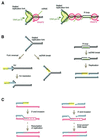The connection between transcription and genomic instability
- PMID: 11823412
- PMCID: PMC125829
- DOI: 10.1093/emboj/21.3.195
The connection between transcription and genomic instability
Abstract
Transcription is a central aspect of DNA metabolism that takes place on the same substrate as replication, repair and recombination. Not surprisingly, therefore, there is a physical and functional connection between these processes. In recent years, transcription has proven to be a relevant player in the maintenance of genome integrity and in the induction of genetic instability and diversity. The aim of this review is to provide an integrative view on how transcription can control different aspects of genomic integrity, by exploring different mechanisms that might be responsible for transcription-associated mutation (TAM) and transcription-associated recombination (TAR).
Figures

References
-
- Aguilera A., Chavez,S. and Malagon,F. (2000) Mitotic recombination in yeast: elements controlling its incidence. Yeast, 16, 731–754. - PubMed
-
- Beletskii A., Grigoriev,A., Joyce,S. and Bhagwat,A.S. (2000) Mutations induced by bacteriophage T7 RNA polymerase and their effects on the composition of the T7 genome. J. Mol. Biol., 300, 1057–1065. - PubMed
-
- Betz A.G., Milstein,C., Gonzalez-Fernandez,A., Pannell,R., Larson,T. and Neuberger,M.S. (1994) Elements regulating somatic hypermutation of an immunoglobulin kappa gene: critical role for the intron enhancer/matrix attachment region. Cell, 77, 239–248. - PubMed
Publication types
MeSH terms
LinkOut - more resources
Full Text Sources
Other Literature Sources

